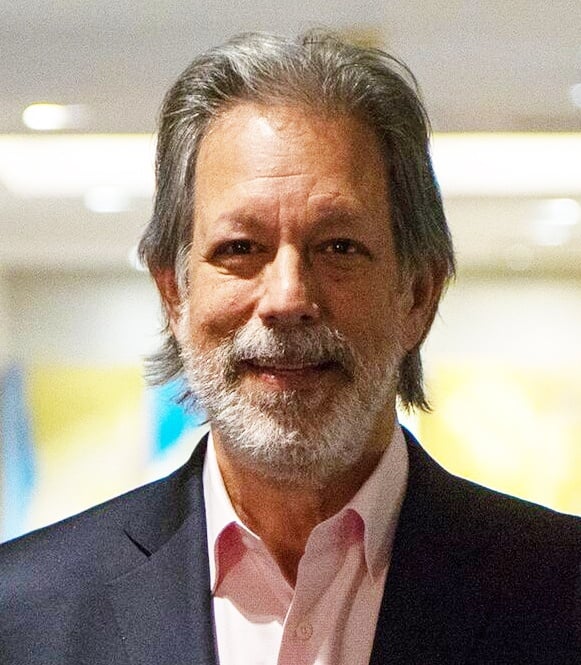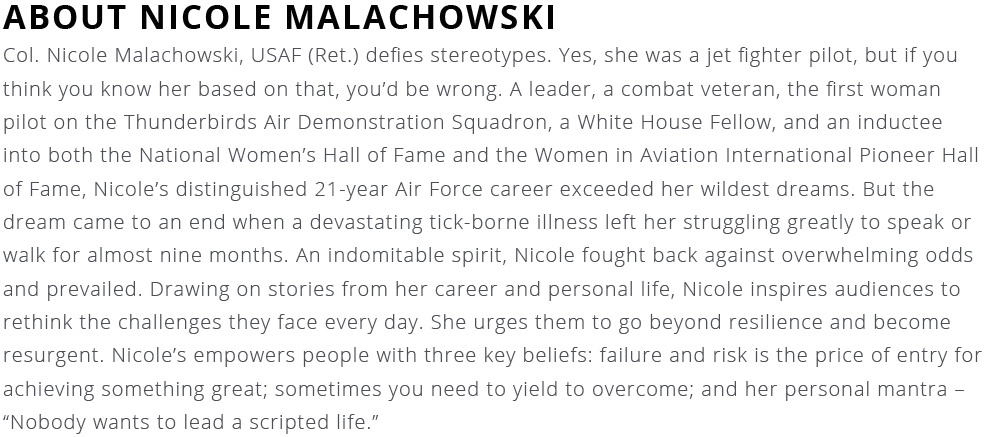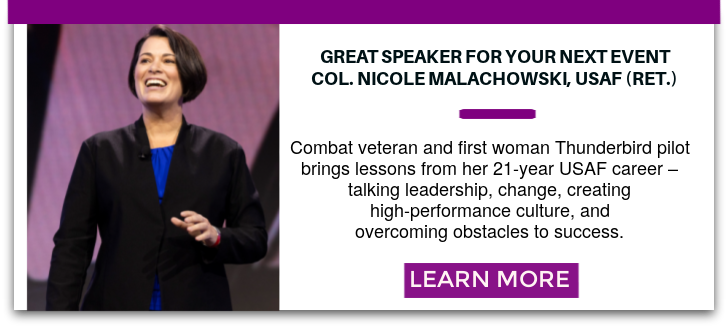LEADERSHIP Q&A: FIRST WOMAN USAF THUNDERBIRD PILOT IS ROCK-STAR AVIATOR
COL. NICOLE MALACHOWSKI (USAF, RET.) has an indomitable spirit. Determined from the age of five to fly fighter jets, she went on to a distinguished 21-year career in the United States Air Force and became the first woman to be part of the Thunderbirds, the elite USAF air demonstration squadron. The ultimate high-performance-under-pressure team, Nicole and five other Thunderbirds flew at over 400 mph and 300 feet off the ground – separated by as little as 36 inches. Nicole is a rock star in military aviation and was inducted into the Women in Aviation International Pioneer Hall of Fame Museum.
Nicole just retired from the Air Force on December 29, 2017. Her career included leadership roles as squadron commander, combat missions in Kosovo and Iraq, time as a White House Fellow and then adviser in the White House for Presidents Bush and Obama.
As a keynote speaker, Nicole is now taking the lessons learned during her remarkable USAF career and sharing them with audiences. A top motivational speaker, Nicole inspires people to aim high and achieve more than they ever thought possible. Her talks focus on leadership, managing change, and creating a high-performance culture.
Peak performance under pressure: COL. NICOLE MALACHOWSKI (USAF, RET.) -- first woman Thunderbird pilot, combat veteran, and White House Fellow -- offers leadership and life lessons from a 21-year USAF career.
Invite her to speak at your next event.
In this interview, Nicole reflects on her determination to achieve her dream of flying fighter aircraft, her groundbreaking role in the Thunderbirds, and her pride for the role she played serving her country and protecting her fellow troops in combat.
Q&A with Nicole Malachowski USAF, (Ret.)
Why did you join the Air Force?
NICOLE: I joined the Air Force for a couple of reasons. Both of my grandfathers had been career military, Navy and Army, and my father had also served in the Army during Vietnam. So, I was raised on those military stories, those stories of patriotism and I grew up in a household where it was considered noble and honorable and a good thing to do to serve your country. And from the time I was five years old, I’ve loved fast aircraft -- fighter aircraft. When you put those two things together, aviation with the love of military service, the natural answer for me was to join the Air Force.
What was the impact of the air show when you were a five-year-old child?
NICOLE: My parents took us to an air show in central California and I saw an aircraft called the F4 Phantom flying. The F4 aircraft was the workhorse of the Vietnam War -- it was loud and it was fast and you could smell the jet fuel. What more would a five-year-old kid want? That was the day I decided I wanted to be a fighter pilot. I remember looking at my dad and saying, “Dad, I want to be a fighter pilot. And I remember him saying, ‘You’ll be a great fighter pilot someday.’”
But When you were five, women weren’t allowed to fly.
NICOLE: Right. Women were not allowed to fly fighter or bomber aircraft. In fact, 1979 was the first year that women were even allowed into modern pilot training. It’s interesting that I’ve grown up simultaneously with the evolution of women military aviators. It’s also important to note that America’s first women military aviators actually flew in World War II: the Women Air Force Service Pilots, affectionately known as “the WASP.” Countless women military aviators, myself included, have followed in their trailblazing footsteps and benefited from their legacy. We owe so much to the vanguards who came before us.
When you joined the Air Force, were you aware of the obstacles?
NICOLE: I did not become aware of the obstacles until I was about 12 years old. There’s an interesting story behind that: when I was in the sixth grade, all of us had to stand up and talk about what we wanted to be when we grew up and how we were going to get there. Here I am, 12 years old, in front of all my peers, and a lot of people started laughing! “Girls can’t be pilots, girls can’t be fighter pilots, etc...” and I remember my teacher informing me, very unceremoniously, that it was against the law for women to fly fighter aircraft. And I remember running home to my dad. My dreams that I have had since I was five were being shattered right before my very eyes. That realization was hard for a 12-year-old girl, it was hard to realize that everything I thought I could do, that I wanted to do, that I dreamed of doing, wasn’t going to be allowed because of some law.
COL. NICOLE MALACHOWSKI (USAF, RET.) - Overview Video
What did your dad say?
NICOLE: My dad told me that laws change and I needed to stay focused on my goals. Maybe I couldn’t fly a fighter aircraft, but I could still fly aircraft, I could be an airline pilot, I could fly the tanker or trainer aircraft in the military. And it was when I was 12 years old, at this devastating moment, that my dad and my grandfather introduced me to the Civil Air Patrol. I joined the Civil Air Patrol and that’s where I got my first flying lessons. I stayed focused.
That focus paid off! Fast-forward a few years and you served as a combat pilot in Iraqi Freedom. Tell me what a job like that entails?
NICOLE: Well, when you fly into combat or serve in a combat theater, it’s really about doing what you’ve been trained to do. There’s a sense of pride in going to war along with your brothers and sisters whom you know are your wingmen and are going to have your back. There’s a sense of seriousness, a sense of huge responsibility. There is a somberness to that because what we’re talking about, at the end of the day, is life and death. There’s nothing celebratory about it. I flew the F-15E Strike Eagle and a lot of that had to do with what’s called CAS, close air support. We would go in and we would help out during what we call TICs, T-I-C stands for troops in contact. When you get on the radio and there are American soldiers or coalition forces pinned down, taking enemy fire and shooting back, you have to take responsibility and do this right. When a young soldier or Marine is yelling for help on a radio it becomes very personal very quickly -- lives are depending on you. It’s taxing mentally, it’s taxing emotionally. But that also means there is great satisfaction that you get as a fighter pilot or a fighter WSO in the F-15E, knowing that you helped that American or allied military member.
You were the first female pilot selected to fly in one of America’s premier air demonstration squadrons, who were they and what was your role in the Thunderbirds?
NICOLE: The Thunderbirds are exactly that, United States Air Force’s aerial demonstration team. Their job pretty much is to go out there and represent all the men and women of the United States Air Force, to show and share their story with the American people. We want to recruit the next generations of Americans to come in and continue to make this the greatest Air Force in the world. And it was also important to retain the best of our Airmen to go out, to thank our Airmen, to meet our Airmen, to see what they need. So, The Thunderbirds are a very public face of the United States Air Force. I served as Thunderbird #3: I flew in the right-wing position in the diamond formation. Yeah, it was awesome – it went by too fast! It’s hard work, too, by the way.
What did your parents think?
NICOLE: My parents were absolutely overwhelmed. We’re from Las Vegas, Nevada, so we were familiar with Nellis Air Force Base. My dad would beam with pride -- he was the one who would wear the Thunderbird t-shirts and walk around and let everybody know that his daughter was up there flying. My mom, on the other hand, always closed her eyes and cringed at different moments, probably like any mother would. I’m not sure she ever saw a complete air show!
You were also the commander of a fighter squadron. What leadership skills are required for that?
NICOLE: As a commander of the 333rd Fighter Squadron, my job was to take care of the Lancer Mission. The mission’s purpose is to train the newest F-15E aircrew to be ready to go out to their first operational squadron. So, in essence, we would get in a whole bunch of lieutenants straight from pilot training or from NAS school and we would teach them -- starting with the very basics -- how to fly the F-15E. From a leadership perspective, my number one priority was taking care of the Lancer Mission and I did that by taking care of my people, by taking care of instructors who were assigned to me. Most of them were young captains, so I made sure that I empowered and enabled an environment where they could be successful. They were amazing instructors. They were the most combat experienced cadre of instructors the F-15E had ever seen. It was really about breaking that experience down to be teachable to a brand-new young lieutenant. How do you empower and enable creative thinking and ensure an innovative environment? We will always hold each other up to the highest standards and we were all accountable for our actions. If you can create and then lead from that kind of environment, the mission gets done.
SUPPLEMENTAL READING:
Col. Nicole Malachowski (USAF, Ret.), First Woman Thunderbird Pilot, Joins DN
Why is it important that you spend so much time mentoring?
NICOLE: I’ve had an unbelievable career for which I’m so grateful to the Air Force for the opportunities, and along the way, I’ve always had something to look forward to, someone to look up to and I feel like it’s just a way of paying it forward. And I’ll be honest, it really solidified when I was on the Thunderbirds. I spent my career trying not to stand out for being a woman. The aircraft doesn’t care, it just wants to be flown. It doesn’t matter if you’re a man or a woman or where you come from, gender doesn’t have anything to do with it. I never tried to fit in with the guys, I’ve always been myself. I’m acutely aware that I’m a woman. But I had spent the first part of my career just not trying to highlight or stand out for the fact that I was a woman – in my mind, it didn’t matter and it shouldn’t matter. Then I became an Air Force Thunderbird and I recognized something that I hadn’t understood before: it means something to see someone who looks like you succeeding. When I would stand in that autograph line, and there were dozens upon dozens of young girls waiting, I realized that it’s not about me – it’s about what I represent to them and their hopes and their dreams and the responsibility of living up to those expectations. What an honor and what a privilege! Everyone’s got a unique story to tell and if somebody’s interested in mine or if I can be that person who encourages them, if I can be that person who says, “Yes, it’s okay to dream big! Don’t be afraid of that!” I’ll absolutely be that person! I love it. I love seeing light bulbs coming on in young kids. I love it when kids realize, “You know what? I am capable of that!” It makes me feel pretty proud.
What will you miss most about the Air Force?
NICOLE: I will miss the people most of all. There is a real beauty in being surrounded, every day, by people who have committed their lives to being a part of something so much bigger than themselves. No matter our backgrounds, where we came from, we shared a common set of values and a single mission. We defended American ideals, we defended American values, and we defended each other, even in the most difficult of circumstances...anywhere, anytime, together. I'll miss that...but I remain so honored to have been a part of such an elite tribe of great Americans. What a privilege it was, indeed.
About Tony D'Amelio
Tony has spent his career putting talented people and audiences together, first in the music business and later representing the world's leading speakers. After concluding 27 years as Executive Vice President of the Washington Speakers Bureau, Tony launched D'Amelio Network, a boutique firm that manages the speaking activities of a select group of experts on business, management, politics and current events. Clients include: Mike Abrashoff, Mariana Atencio, Chris Barton, Lisa Bodell, Geoff Colvin, Daryl Davis, Suneel Gupta, Ron Insana, Katty Kay, Polly LaBarre, Nicole Malachowski, Ken Schmidt, and Bob Woodward.

.png)

.jpg)



